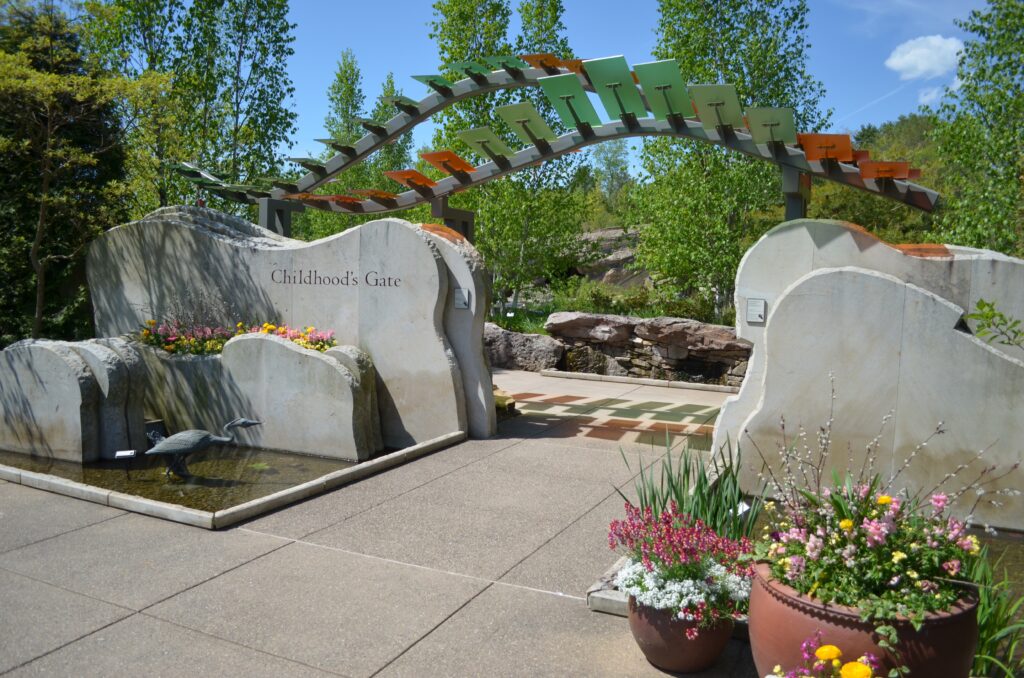The Arboretum at Penn State is a longtime goal of the university that was finally achieved in 2009 and since then has become one of the most popular campus destinations.
The university’s early leaders envisioned the campus as an arboretum in many respects. William G. Waring, the first professor of horticulture who was actively involved in laying out the grounds, planted many of the early shade trees, including the first elms. In the 1870s and 1880s, botanist William Buckhout and others planted shrubs and trees throughout the campus. Penn State’s first master plan, designed by landscape architect Charles Lowrie of New York City and published in 1907, included gardens and greenhouses north of the agriculture buildings, near Hort Woods.
In 1914, the university’s Board of Trustees set aside twenty-five acres in what is now the northeast corner of the Penn State Golf Course for a living collection of trees, plants, and shrubs. No funding was available, however, and the project was shelved. Ten years later, landscape architect Warren H. Manning created a comprehensive plan for the university that included an arboretum. At the time, Manning confided to a trustee that an arboretum probably was not practical without a large endowment to fund it.
During the next 70 years, plans for an arboretum were discussed regularly, but funding could never be secured. Penn State’s senior classes of 1927-1931 even pledged their annual class gifts to the arboretum, but the Great Depression made it impossible for the university to secure enough money to fund the project.

Finally, in 1996 Penn State leaders agreed to develop an arboretum managed by the university but funded by private donations. Four years later, a landscape architecture firm was hired to create plans for a 370-acre tract of land on Park Avenue, just east of College Heights, to be called The Arboretum at Penn State.
On September 28, 2005, the “Hosler Oak,” the first tree planted at the arboretum, was planted in honor of Dr. Charles L. Hosler, senior vice president and dean emeritus of the Graduate School. Penn State alumnus Charles H. “Skip” Smith donated $10 million to fund construction of the H.O. Smith Botanic Gardens in honor of his father, as well as improvements to the front thirty acres, the Overlook Pavilion, and the beginning of a tree collection. With that major gift and others, construction began on the arboretum and it opened in 2009.
The arboretum includes the Marsh Meadow along Park Avenue. Filled with tall switch grass and trees around the perimeter, the meadow also serves the functional purposes of infiltrating storm water into the underground aquifer. The Strolling Garden encircles the event lawn with a paved path bordered by flowering shrubs and perennial plants.
An unusual feature of the arboretum is the Ridge and Valley Sculpture, a three-dimensional map that depicts the Spring Creek watershed surrounding the university. When it rains, runoff from the roof of the Overlook Pavilion drains onto the map and flows along the carved waterways, creating a miniature watershed. The arboretum also includes the Bellefonte Central Rail Trail, a crushed limestone path that follows the former railroad bed for 1.3 miles through the Big Hollow portion of the property.
The Childhood’s Gate Children’s Garden opened in 2014. (The name “Childhood’s Gate,” was inspired by a line in Penn State’s alma mater, “When we stood at childhood’s gate.”) It includes sculptures, limestone cave, vegetable garden, and greenhouse. In 2021, the Pollinator and Bird Garden opened at the Arboretum. The three-acre garden, which features about 390 species and varieties of plants, is designed to demonstrate how to create attractive pollinator- and bird-friendly landscapes.
The arboretum hosts several annual events, including the Pumpkin Festival and the Winter Celebration. It annually attracts more than 150,000 visitors.
Ford Risley
Source:
The Arboretum at Penn State. www.arboretum.psu.edu (Accessed July 17, 2021).
Trainer, Walter W. Campus Trees and Shrubs. State College: Pennsylvania State College, Department of Grounds and Buildings, 1946
First Published: March 10, 2021
Last Modified: April 29, 2024
